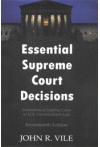
- Author(s): John R Vile
- Publisher: MPP House
- Edition: 17 Ed 2020
- ISBN 13 9788194590248
- Approx. Pages 604 + Contents
- Format Paperback
- Approx. Product Size 24 x 16 cms
- Delivery Time 3-5 working days (within Kerala & South India) (Others 7-9 days)
- Shipping Charge Extra (see Shopping Cart)
............................................................................................
Description
Almost sixty-five years and sixteen previous editions of continuous use have established the value of this volume. This value stems from the gravity of the subject it treats. American constitutional law is as important and exciting as the drama of constitutional government. In addition to its intellectual appeal, constitutional law has practical consequences. Because the United States has a written constitution enforceable in courts, citizens find that guarantees of political participation and basic rights are realities rather than mere aspirations. Like many important subjects, the study of constitutional law can be difficult. Undergraduates in political science and history often find classes in constitutional law to be among the more demanding studies that they encounter within the social sciences. Similarly, law students generally find classes on constitutional law to be at least as challenging as classes on torts or contracts. There are a variety of reasons for this. Although cases involving civil rights and liberties are often quite engaging, contemporary, cases involving judicial review and jurisdiction, separation of powers, federalism, congressional powers under the commerce and taxing clauses, and the like (typically the staple of opening weeks of a single course or first-semester courses of a two semester sequence on U.S. constitutional law) may seem quite arcane. More-over, the Supreme Court has a long history, and important cases frequently originate from earlier centuries. Such cases often focus on technical questions about issues that are not exactly in today's headlines or that are not generally understood. In the author's experience, for example, few students who begin constitutional law understand that the Supreme Court applies most rights in the first ten amendments to the states not directly, but via the due process clause of the Fourteenth Amendment (see chapter 8 on the Bill of Rights and its application to the states); fewer still are likely to come into class thinking about subtle distinctions between state and private action.
............................................................................................
Table of Contents
1. Article I : The Legislative Branch
2. Article II : The Executive Branch
3. Article I & II : Distinct Yet Overlapping Powers
4. Article III : The Judicial Branch
5. Article IV & VI : Federalism
6. Article V & VII : Constitutional Amending Process and Ratification of the Constitution
7. Property Rights
8. The Bill of Rights and its Application to the States
9. First Amendment: Religious Rights
10. First Amendment : Political Rights
11. Second, Third, and Fourth Amendment
12. Fifth, Sixth, Seventh, and Eighth Amendments
13. Ninth Amendment: Right to Privacy, and other Unenumerated Rights
14. Thirteenth and Fourteenth Amendment
15. Voting Rights
Index
............................................................................................
Author Details
John R Vile
